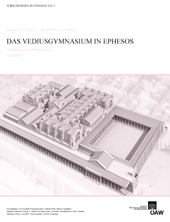Martin Steskal
ist externer Lehrbeauftragter am Institut für Klassische Archäologie an der Universität Wien
Martino La Torre
ist Lehrbeauftragter im Fachbereich Architektur an der Fachhochschule Wiesbaden
|
 |
Zwischen 147 und 149 n. Chr. wird im Norden von Ephesos auf einer Fläche von knapp 13.000 m² ein Bad-Gymnasium-Komplex eröffnet, der nach seinem Stifter, M. Claudius P. Vedius Antoninus Phaedrus Sabinianus, heute als Vediusgymnasium bezeichnet wird. Die als Kombination einer römischen Therme mit einem griechischen Gymnasium konfigurierte Anlage entspricht dem Idealtypus der vor allem in Kleinasien anzutreffenden Thermengymnasien. Die vorliegende Publikation nimmt die bereits in den 1920er und 1950er Jahren begonnenen Untersuchungen wieder auf, um nunmehr nach sechsjähriger Feldarbeit und Aufarbeitung eine Endpublikation des Monumentes vorzulegen. Diese beinhaltet sowohl die theoretische Rekonstruktion des Bauwerks mitsamt seiner Ausstattung und die Klärung der technischen Aspekte der Therme als auch eine archäologisch-historische Auswertung der Anlage, die die Nutzungs- und Baugeschichte des Bades beleuchtet. Die Arbeit thematisiert einen monumentalen Gebäudetypus, der das Stadtbild der Metropolen des griechischen Ostens prägte und als Zentrum des öffentlichen Lebens galt. Multifunktional angelegt dienten die Thermengymnasien als Treffpunkte von Vereinen, als Austragungsort unterschiedlichster Veranstaltungen, als Ausbildungsstätten und nicht zuletzt als Orte der körperlichen Ertüchtigung, der Körperpflege und Erholung. Das wechselhafte Schicksal eines der vier großen ephesischen Bad-Gymnasien soll im Zuge dieser Publikation dargelegt werden.
Gedruckt mit Unterstützung des Fonds zur Förderung der wissenschaftlichen Forschung
… In the years between 147 and 149 A.D. an almost 13.000 m² bath-gymnasium complex was opened in the north of Ephesos, the sponsor of which, M. Claudius P. Vedius Antoninus Phaedrus Sabinianus, gave it its current name, Vedius gymnasium. The combination of Roman baths and Greek gymnasium is an example of the model type of the bath-gymnasium mainly found in Asia Minor. This publication is the continuation of the research started in the 1920's and 1950's and the result of six years of archaeological field work which is now presented in the final publication of the monument. It includes the theoretical reconstruction of the building, its furnishings and the clarification of various technical problems of the baths as well as the archaeological-historic relevance of the complex that explains the usage and the history of the building. The discussion also takes account of the monumental building type that strongly influenced the city structure of the metropoleis of the Greek east and belonged to the core of society. The multifunctional purpose of the bath-gymnasium made it a meeting point for clubs, events took place here, educational needs were met and last but not least it was also used as a place for exercise, body care and general recreation. This publication tries to explain the eventful life of one of the four large Ephesian bath-gymnasiums. |



 Home
Home
 Print
Print
 References
References
 Share
Share